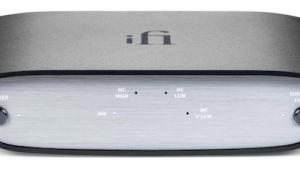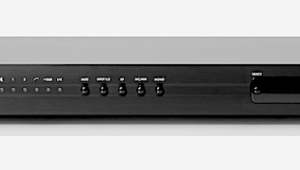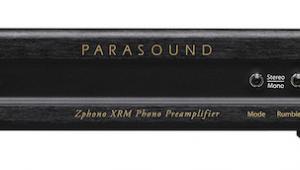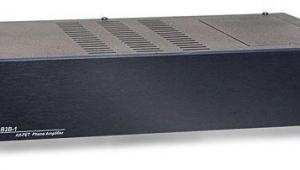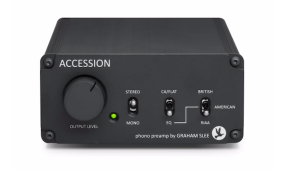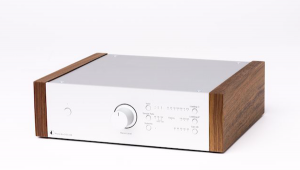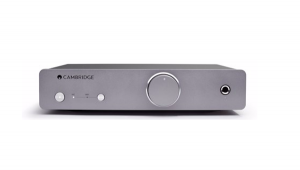Herron Audio VTSP-1 preamplifier & VTPH-1MC phono preamplifier Page 2
The VTSP-1's balance control uses a shunt circuit that, according to Herron, is "barely" in the circuit when at its center position. It's certainly more convenient to use than the dual stepped attenuators found in the Audible Illusions 3A, and adds flexibility not found in my reference Ayre K-1, which provides no way to adjust individual channel level.
The VTSP-1 line stage uses four 6922 tubes in what Herron describes as a "distortion-canceling arrangement wherein the 6922s are run with their gain close to maximum at specific plate currents in a way that allows the opposing nonlinearities in transconductance and plate resistance to cancel out. This requires a unique circuit...[which] also operates the tube sections at low plate voltage and current, which results in cool operation and long tube life." No global feedback is used in the design.
Herron also emphasized the need for the shortest possible signal paths from the inputs to the electronics---accomplished here by using sealed, gold-plated input switching relays mounted along the back of the chassis, directly adjacent to the inputs. The front-panel selector operates merely as a relay control. Selecting an input closes a relay, which routes the signal from the input to the stepped attenuators, positioned next to the input tubes.
According to Herron, many of today's line stages are designed with lower input impedances (he calls this a "design shortcut") to reduce crosstalk and improve high-frequency response. Unfortunately, he says, when the source component is loaded below 100 times its output impedance, its third-order harmonic distortion rises significantly. In other words---again, according to Herron---the designer of a low-impedance input line stage is willing to sacrifice the performance of the source product in order to make the line stage's specs look better!
Careful circuit design and critical board layout allow the VTSP-1 to have a high, 100k ohms input impedance as well as outstanding crosstalk and high-frequency response specs. Herron also emphasized that the circuit does not include sound-degrading electronic clocks, which is why remote control is not available. (Charlie Hansen's Ayre preamps offer remote control without clocks or microprocessors. The Mark Levinson No.32's microprocessor "goes to sleep" after each operation.)
The line stage's onboard power supply features a toroidal transformer, extensive filtering, and several levels of voltage regulation. Tube life is prolonged with gradual ramp-up of DC filament power and high voltage at power-on.
VTPH-1 & VTPH-1MC phono preamplifiers
While many manufacturers offer a single phono preamp with switchable moving-coil/moving-magnet capabilities, Herron's preoccupation with keeping voltages ultra-low and currents away from signal-path switches necessitated two models: an all-tube-signal-path MM version and the high-gain FET/tube hybrid auditioned for this review.
The tubes---four 12AX7WBs, one 12AT7WC---are run using the same "distortion-canceling arrangement" found in the Herron line-level preamp. As with the VTSP-1, the VTPH-1 uses no global feedback. The low-loss, passive RIAA equalization filter was designed with the aid of a computer and Herron's ears. He told me that hundreds of combinations were tried, all using "real parts that we could purchase, and at impedances that were optimized for the tube circuits." He added that the "correct circuit was found on April 22, 1996, and everyone here knew when they heard it that it was right." Parts used for the RIAA filter are hand-picked, with typically 97% being rejected, he said.
The MC version's FET front end, constructed on a small circuit board fastened to the input jacks and grounding post, consists of a single, zero-feedback, low-noise amplifier with 22dB gain---said to be sufficient for even the lowest-output (below 100µV output) cartridges. Yet the MC model can, according to Herron, accept the 4mV output of a Shure V15VxMR without overload.
The main circuit is laid out on a large, double-sided circuit board. The VTPH-1 and 1MC use star grounding, which means every signal ground has an independent path to a central ground point. The power supply is said to provide a rigid voltage supply to the tubes (the manufacturer's info sheet claims the phono section will operate normally with an AC supply between 90 to 140 volts at 50 or 60Hz), and features a separately regulated tube bias supply, four levels of high-voltage regulation, a regulated soft-start DC filament supply, and 78,000µF of energy storage.
- Log in or register to post comments





